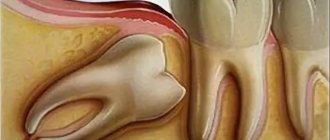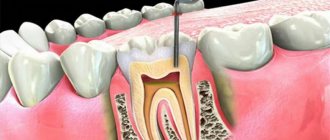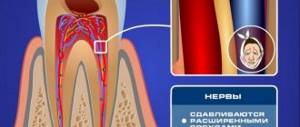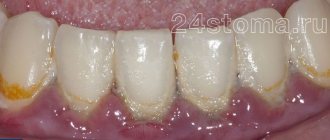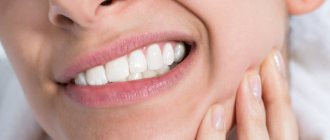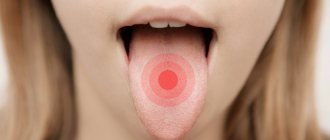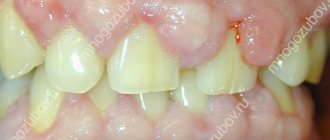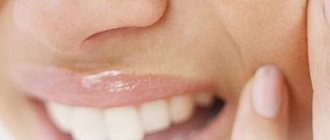From this article you will learn:
- why does the tooth under the crown hurt,
- what causes inflammation of the gums under the crown,
- how to treat a tooth under a crown.
There are only a few reasons why a tooth hurts under a crown. And almost all of them are associated exclusively with poor preparation of the tooth for prosthetics, i.e. with poor quality root canal filling. And here, if we look at the official statistics in dentistry, we will see that root canals are filled by dentists with poor quality even in more than 60-70% of cases. However, there are several other much less common causes.
For example, inflammation of the tooth under the crown, pain when biting and swelling of the gums can also occur in cases where living (not pulpless) teeth were taken under the crowns. In this case, the development of inflammation will not be associated with poorly filled root canals, but with a thermal burn of the pulp caused by the dentist during the process of grinding the tooth for a crown. In this case, one, several months or a year after prosthetics, the patient may first feel pain or other symptoms of inflammation.
As a rule, a burn of the pulp (neurovascular bundle) located in the center of the tooth occurs either due to insufficient water cooling of the tooth during the grinding of its hard tissues, but even more often due to the fact that the doctor is simply in a hurry. Also, another reason for the development of inflammation in a tooth under an artificial crown can be caries of the root of this tooth.
Causes of tooth pain under the crown
It is almost impossible to instantly understand the exact localization and etymology of this unpleasant symptom. Each clinical case requires a separate, thorough diagnosis. However, regardless of these nuances, it is necessary to consult a doctor as quickly as possible, since even a slight delay can aggravate the situation.
It is important to understand that pain when pressing on the prosthesis can appear at any time after dental prosthetics, so only after a preliminary examination will the dentist be able to prescribe the correct therapy.
Perforation in the channel
This complication quite often explains why teeth ache under crowns. It represents a violation of integrity, the formation of a small passage through which the inflammatory focus and surrounding tissues are combined. This process leads to infection and involvement of healthy anatomical structures in pathology. As a rule, a crack is formed due to carious cavities or mechanical injuries.
Poor quality filling
Despite the fact that this is the most popular dental procedure, some specialists often make mistakes in its implementation. Undesirable consequences can also be caused by poor-quality equipment, a low level of professionalism of the dentist and poor material that can:
- Fall out shortly after installation.
- Cause discomfort while chewing, when talking, and even in the absence of any load.
- Injure the surrounding gums and lead to periodontitis.
Poor workmanship often causes the problem to spread. Swelling of the soft tissues of the jaw is also observed.
Foreign body in the canal
Knowing what to do when a tooth hurts under a crown can prevent a large number of serious consequences. However, few people manage to prevent a foreign object from entering the dental cavity. As a rule, this is an element of endodontic instrumentation that has been broken during the process of deep cleaning, accompanied by the treatment of narrow and curved passages. The presence of even a small fragment creates many problems with filling the remaining sections of the canals, which leads to local irritation. Therefore, it is extremely important to promptly remove the foreign object and get rid of other contaminants.
Inflammation of the gums around the denture
At the initial stages of the inflammatory process, medicinal ointments, gels and special creams can help eliminate this symptom. But if the pathological condition progresses or you visit a doctor late, more serious intervention will be required. As a rule, the clinical picture is accompanied by swelling, hyperemia and bleeding, which indicates deterioration. The inflammatory process occurs due to:
- Incorrectly selected prosthesis. Because of this, damage occurs to the gums, which are affected by insufficiently turned corners, a hard base and other possible shortcomings.
- Allergic reaction. Even though modern materials are designed to be hypoallergenic, some people may develop allergies.
- Incorrect distribution of chewing load.
Incorrect installation of dentures
This procedure is focused on the professionalism of the dentist, as it is a difficult and lengthy job that can only be handled by a highly qualified specialist. However, not all medical workers have the proper knowledge, practical skills, attentiveness and accuracy. The most common mistakes are:
- Bad form. The defect occurs due to the incompetence of the dentist or a poor-quality cast of the patient’s jaw. As a result of this, a gap is formed between the prosthesis and the soft tissues, where food debris gets trapped. The opposite situation is also possible, in which the structure is large, causing its edge to rub and damage the gums.
- Incorrect prosthesis or its components. In order not to worry about why teeth under crowns hurt, how to treat and avoid this condition, it is worth choosing suitable materials for prosthetics in advance. To do this, it is important to take into account not only personal preferences, but also indications, history of diseases and contraindications (for example, steel is prohibited for diseases of the mucous membrane).
- Insufficient sanitation of the oral cavity. Because of this, the risk of developing caries, gingivitis, osteomyelitis and other infectious diseases significantly increases.
Consequences of refusing therapy
If the patient is inactive while his body is “screaming” for help, signaling pain, he risks significantly worsening the problem.
Self-medication under such circumstances is unacceptable. It is recommended to use traditional medicine recipes only as an emergency aid.
If the pain does not subside for a long time, you should urgently visit a doctor. Only he can fix the problem quickly and without consequences.
If you do not treat a diseased tooth, then over time an abscess will form on the gum tissue. The swelling spreads to the face, distorting the correct contours of its tissues. Purulent inflammation of the periosteum cannot be eliminated without removing the tooth and, accordingly, the crown.
Symptoms associated with pain
Pathologies arising under a microprosthesis are accompanied not only by this clinical sign. Therefore, the patient needs to carefully monitor changes in his health and share observations with the doctor. In most cases, such patients experience bleeding gums and accumulation of purulent masses, which give an unpleasant taste and odor from the mouth. In addition, it is possible:
- Loosening of the tooth (its excessive mobility).
- Hyperemia and flux.
- Increased sensitivity of enamel.
- Itching, discomfort and plaque.
If the source of the disease is localized in the pulp, the pain becomes acute. It mainly worsens at night. You can learn more about the treatment of pulpitis and periodontitis in our other article. If this is caries, then an increase is observed when eating hot or cold food.
Recovery after the course
Recovery after taking antibiotics is simply necessary for every body. In most cases, the gastrointestinal tract is at risk. Signs may include: indigestion and congestion. It is recommended to consume more dairy products, and the doctor may also prescribe drugs to restore microflora - Linex, Acipol, Hilak Forte. They are usually taken along with antibiotics.
"Linex" capsules
Lactobacilli
"Hilak forte"
Multivitamin preparations will also play an important role in restoring the body after a course of antibiotic therapy.
Multivitamins will help the body recover faster
What to do when a living tooth hurts under a crown
In the first stages, only strengthening the enamel is enough. The affected tooth surface is treated with a special brush, after which it is treated with a remineralizing substance of calcium, magnesium and potassium. If deep caries damage occurs, then serious mechanical intervention will be required - removal of damaged tissue and filling of cavities.
In addition, the following are used in dental practice:
- Infiltration. Manipulation is prescribed for carious damage in the form of spots. A special ICON resin is applied to the tooth, destroying bacterial flora and filling the resulting pores. Its duration does not exceed 20 minutes and has minimal mechanical impact.
- Ozone therapy. Ozone has strong antibacterial properties and is also an excellent oxidizing agent. Thanks to this, it effectively destroys bacteria and prevents their proliferation.
- Air abrasive cleaning. Carious cavities are treated with a finely dispersed stream of abrasive elements. This makes it possible to refuse the drill.
- Laser. If your teeth ache under a crown and you don’t know what to do, then you should definitely visit a dentist. Today, laser equipment is actively used, which also allows you to cope with the task without a drill. However, this will require local anesthesia.
- ART technique. The affected tissue is removed with a modern instrument, and the resulting cavity is filled with glass ionomer cement.
Methods for treating a tooth without a nerve
If there are no nerve endings, then the treatment process becomes much more complicated and lengthened. If a crack has formed in the area of the root system, then restoration is carried out using implantation or a metal-ceramic crown. It allows you to protect against the penetration of air, infections and moisture. Due to the tight fit to the dead tooth, it is possible to restore not only its shape, but also its color shade.
After removing the nerve, you can resort to installing a ceramic prosthesis. This technique is in demand when dental integrity is destroyed by at least 30%. It has a longer service life, so it significantly extends the life of damaged plates.
What complications may arise?
Pain in a dead tooth necessarily indicates the presence of some pathology that needs to be eliminated in a timely manner. Infection can lead to serious consequences:
- complete destruction and death of the tooth;
- chronic gum inflammation;
- development of periodontitis, gingivitis;
- the appearance of cysts.
In addition, failure to seek medical help in a timely manner can lead to the development of systemic infections that spread from the periosteum through the bloodstream throughout the body!
How to relieve pain at home
If the tooth under the crown hurts, what should you do about this problem? There are several methods of pain relief, including taking NSAIDs and rinsing the mouth with soda or herbal solution 3 hours after eating. However, you need to know that these are only temporary measures, so if you observe any alarming symptoms, you should immediately contact a dental clinic. Also, experts categorically prohibit:
- Heating. High temperature promotes bacterial growth.
- Refusal of the pillow. The head must be fixed in an elevated position, as this ensures normal blood flow.
- Antibiotics. Before taking antibacterial agents, you need to consult a doctor, as the composition and dosage can easily be confused.
Painkillers
Since toothache under a crown can be relieved with the help of medications, for these purposes it is better to use:
- "Ketanov" - offensive effect 30 minutes from the moment of administration.
- “Nise” additionally has an antipyretic effect.
- "Nurofen" - relieves swelling, inhibits inflammation. It is distinguished by the rapid onset of the desired result - after 25 minutes.
- "Baralgin" - has an antispasmodic, anesthetic and antipyretic effect. Can only be taken after 15 years.
But do not rush to take pills without a doctor’s recommendation, since each drug has contraindications and side effects.
Folk remedies
A number of medicinal plants also have an analgesic effect, the correct use of which helps improve well-being. Dentists recommend:
- Sage. Actively fights inflammation and microbes. Used as a tincture, which requires boiling water. The mixture is infused for half an hour, after which it is used to rinse the mouth every 4 hours.
- Oregano. This herb also has an antiseptic and antifungal effect. To prepare the decoction, you need to take 2 tablespoons of oregano, which are poured into 250 ml of boiling water.
- Soda. For 1 tsp. powder you need 200 ml of boiled water. Getting the medicine helps fight inflammation and kill germs.
Clinical researches
ASEPTA® mouth rinses are designed to protect gums from inflammation and improve oral hygiene. The main indications for their use are:
- acute and chronic gingivitis;
- acute and chronic periodontitis;
- stomatitis;
- post-extraction alveolitis;
- toothache of infectious origin.
Clinical trials conducted in laboratories have shown that after 3 weeks of using ASEPTA® rinse, gum bleeding is reduced by 28.3%, inflammation is reduced by 32.3% and the hygienic condition of the oral cavity is improved by 33.5%*.
Sources:
- Clinical and laboratory assessment of the influence of domestic therapeutic and prophylactic toothpaste based on plant extracts on the condition of the oral cavity in patients with simple marginal gingivitis. Doctor of Medical Sciences, Professor Elovikova T.M.1, Candidate of Chemical Sciences, Associate Professor Ermishina E.Yu. 2, Doctor of Technical Sciences Associate Professor Belokonova N.A. 2 Department of Therapeutic Dentistry USMU1, Department of General Chemistry USMU2
- Clinical experience in using the Asepta series of products Fuchs Elena Ivanovna Assistant of the Department of Therapeutic and Pediatric Dentistry State Budgetary Educational Institution of Higher Professional Education Ryazan State Medical University named after Academician I.P. Pavlova of the Ministry of Health and Social Development of the Russian Federation (GBOU VPO RyazSMU Ministry of Health and Social Development of Russia)
- Report on clinical trials to determine/confirm the preventive properties of commercially produced personal oral hygiene products: mouth rinse "ASEPTA PARODONTAL" - Solution for irrigator." Doctor of Medical Sciences Professor, Honored Doctor of the Russian Federation, Head. Department of Preventive Dentistry S.B. Ulitovsky, doctor-researcher A.A. Leontiev First St. Petersburg State Medical University named after academician I.P. Pavlova, Department of Preventive Dentistry.
How to treat dental plates without removing orthopedic structures
Not everyone knows whether a tooth under a crown can hurt, and how to eliminate this symptom without destroying it. In this case, a hole is drilled to provide access to living tissue. After which the prosthesis is fixed and excess cement is removed. Important features of treatment in this case are:
- High risk of damage to the microprosthesis.
- Violation of the integrity of ceramic coating requires restoration of the enamel.
- The technique leads to a shortening of the service life of the crown.
- Crown removal and extensive sanitation.
Signs of inflammation
You need to pay special attention to the following symptoms:
- Pain. Most often, its cause is inflammation of the soft tissue under the crown or irritation of the root canals.
- Edema. This is a signal that inflammation has begun.
- A fistula is a channel from which pus comes out; it may appear some time after swelling.
It is worth remembering that after prosthetics, the first two to three days may be uncomfortable. In this case, you do not need to take any additional measures; if pain interferes with the usual course of business, take pain medications.
Prevention methods
To prevent this unpleasant situation, you must follow simple rules:
- Regular and thorough brushing of teeth. It is recommended to do this hygiene procedure twice a day (in the morning and before bed).
- Avoid heavy chewing loads. To do this, you should give up frequent consumption of solid foods (nuts, seeds, etc.).
- Visit the dentist every six months. There is no need to wait for black spots and other symptoms of dental disease to appear. It is required to make an appointment even without any complaints, as this will help identify and eliminate the problem in the early stages of development.
Now you know how to make yourself feel better when a tooth hurts under the crown, what to do in this situation, and also you will not make mistakes that could aggravate your current health condition.
Preventive measures
In order not to encounter an inflammatory process under the crown, it is recommended to adhere to the following rules:
- brush your teeth thoroughly twice every day;
- use mouthwash and dental floss;
- replace the crown in a timely manner, if necessary;
- exclude hard fruits, nuts and sunflower seeds from the diet;
- take vitamin and mineral complexes to improve immunity.
Regarding the prevention of medical errors, it is recommended to undergo an x-ray examination both before and after the prosthetic procedure.
A preventive examination of the crown by a specialist should be carried out at least once every 6 months.
Inflammation of the gums under the crown is always unpleasant and very painful. However, treating this process on your own is extremely dangerous, since incorrect treatment tactics can lead to the inflammatory process deepening and spreading to other organs and systems of the body. In addition, you should not remove the crown yourself - all this can only be trusted by a competent specialist.
Our expert dentist will answer your question within 1 day! Ask a Question

